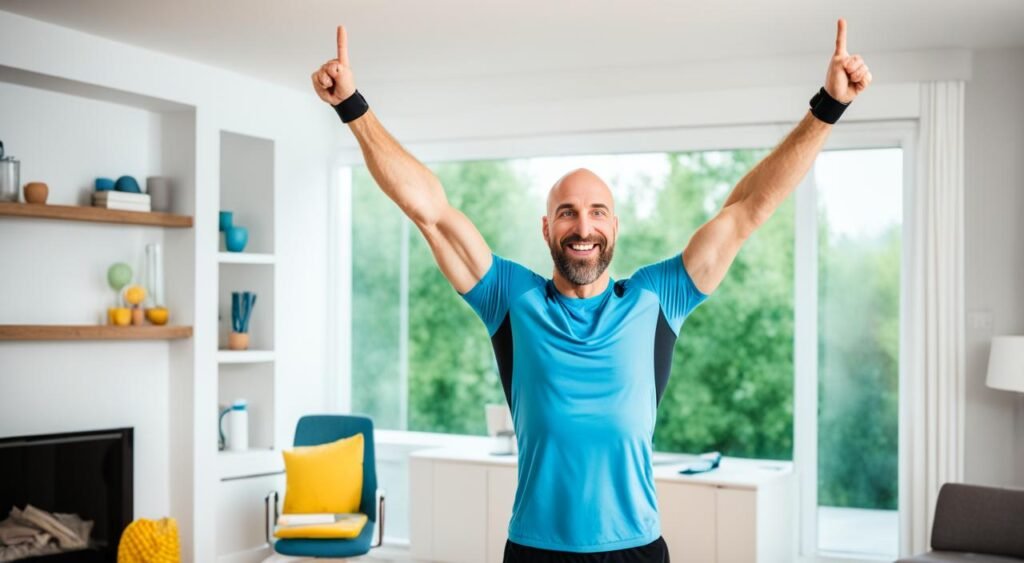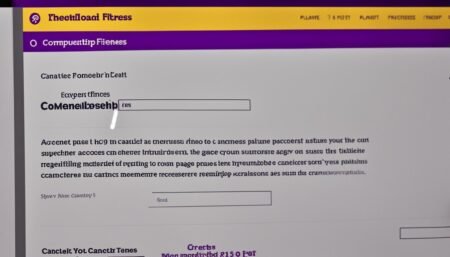Imagine getting closer to your fitness goals from your home. All it takes is thirty minutes a day. This 30-minute workout routine at home is a quick way to change. It fits into your busy life, making you stronger and more vibrant.
Start with beginner exercises1 or take on tougher ones in an advanced program1. Every action shows your commitment. This home exercise routine fits today’s busy life. It’s a way to find balance and renewal in just thirty minutes.
The blend of quick cardio and strength training increases calorie burn2. It strengthens your willpower. A simple home workout plan becomes a way to lasting health.
Key Takeaways
- Maximize fitness gains with a time-efficient 30-minute routine suitable for any schedule.
- Blend cardiovascular and resistance training for comprehensive body benefits.
- Embrace beginner to advanced routines tailored to your fitness level1.
- Benefit from increased calorie burn through strategic workout structuring2.
- Unlock the power of short bursts of exercise to fit a healthy lifestyle into a busy world.
- Personalize your fitness approach with adaptable exercise selections for all skill levels3.
- Recognize even small daily workout achievements for significant wellness impact2.
Introduction to Time-Efficient Home Workouts
Nowadays, keeping fit at home is more important than ever. Our busy lives need quick yet effective fitness solutions. A home fitness routine fits perfectly into this need.
A 30-minute home fitness routine tackles the growing problem of not exercising enough. This issue has been increasing since 20014. Short workouts are a big trend right now. They help many people stay healthy when time is short4.
The Benefits of a 30-Minute Home Fitness Routine
Quick home workouts do more than just save time. They offer real physical benefits too. By working out for just a short time regularly, you can get as strong as with longer sessions4.
This efficient exercise method leads to muscle growth. It’s similar to what you’d get from working out in a gym4.
Understanding High-Intensity Home Exercise Regimens
High intensity is key for a successful workout at home. Studies show that both doing many sets and just one set can build muscle. However, results can vary, especially for beginners4. Yet, the main point is clear. A great workout doesn’t need to be long. What matters is choosing and doing effective exercises4.
Working out at home doesn’t have to be less effective. Research gives us tips on how to make home workouts powerful4. By following science, your home can be a great place for fitness4.
Explore the scientific literature
Learn more about crafting a powerful, time-efficient workout at home.
30-Minute Workout Routine at Home: Getting Started
Starting a healthier life doesn’t need costly gym memberships or fancy gear. Home workout plans are simple, needing just 30 minutes daily. When beginning, it’s key to focus on basic strength and aerobic training to get the most health benefits5.
To begin your home workout, aim for 150 minutes of moderate aerobic activity per week. This can lower your risk for chronic diseases and help with balance5. If you’re aiming to lose or maintain weight, try for 300 minutes of activity instead5. Starting with easy home exercises is important to avoid injury and build a strong fitness base.
Strength exercises are crucial at least twice a week for all major muscle groups. They’re a big part of your home workout plan and help with muscle health5. High-intensity interval training (HIIT) boosts both your aerobic and anaerobic fitness5. Remember to gradually increase your exercise intensity by no more than 10% each week5.
Having clear goals helps measure your progress and keeps you motivated. It’s good to check how you’re doing six weeks after starting, then regularly5. Cross-training mixes up your routine to avoid boredom and injury5. Don’t forget rest days in your workout plan for muscle recovery and to prevent soreness5.
Using fitness apps or devices can keep you on track by monitoring your activity. These tools give valuable feedback on your progress5. Also, tweaking your routine is crucial to match your changing goals and fitness level5.
| Workout Component | Benefits | Weekly Goal |
|---|---|---|
| Moderate Aerobic Activity | Reduces chronic disease risk, improves balance | 150-300 minutes |
| Strength Training | Supports muscular health, increases metabolism | 2+ sessions for each major muscle group |
| High-Intensity Intervals | Enhances aerobic and anaerobic fitness | Incorporate into 2-3 workout days |
| Cross-Training | Prevents boredom, reduces injury risk | Vary workout types weekly |
When you stick to your 30-minute home workout plan, remember progress and consistency. Let your body get used to the exercise gradually and keep challenging yourself. This way, you’ll be closer to being fitter and healthier with every step.
Core Components of a Quick Home Fitness Program
Creating a home workout plan means covering all bases. You’ll want exercises for strong legs, a powerful upper body, and dynamic movements. The Department of Health and Human Services recommends a mix of exercises every week. They suggest 150 to 300 minutes of moderate to vigorous activity to stay fit or shed pounds6. This advice forms the backbone of a solid fitness strategy, tailored just for you.
Squats: Foundation of Leg Strengthening
Squats are key for building leg muscles, working your core and back at the same time. They help with balance, which is especially important for older adults. Add exercises like bridges and planks to improve stability6. This not only helps your joints move better but also straightens your posture. Including yoga can make you more flexible too6.
Dynamic Lunges for Lower Body Power
Dynamic lunges bring energy to your lower body, making them a great addition to squats. Mixing in high-intensity interval training, or HIIT, adds a cardio element. HIIT involves short bursts of intense exercise followed by rest6. This boosts your heart health and builds endurance.
Upper Body Strength: Push-Ups and Variations
Building upper body strength is fundamental. Push-ups and their variations target the chest, shoulders, and triceps. Include two strength training sessions each week. Work on all major muscle groups during these sessions6. Also, exercises like situps and fitness ball routines help strengthen your core.
A well-rounded fitness routine is crucial for success. It should improve balance, strength, and flexibility. Include diverse exercises to touch on every physical aspect. Learn more about making a complete fitness plan with help from the Mayo Clinic’s guidelines on fitness training.
Home Cardio Intervals for Rapid Calorie Burn
Engage in a quick home workout that’s been sculpting physiques and enhancing health since its inception. High-intensity interval training (HIIT) is popular for good reason. It delivers big health perks in just 30 minutes by combining heart-pumping cardio with strength exercises7.
When you’ve got little time but want big calorie burn, home cardio intervals are perfect. They push you hard, making your heart work better and boosting overall fitness7. HIIT is great for everyone. It fits all ages and health levels well7.
Tabata is a HIIT type that really packs a punch. Established in 1996, its intense bursts help shred fat, build strength, and improve health overall7. Most people stick with it because it’s short but super effective. Over 80% finish the program, getting much better aerobic fitness than with lighter exercises7.
HIIT does more than just shape your body. It’s also great for your mind, especially for those battling depression. It beats other exercises in improving moods for people with major depressive and bipolar disorders7. Important research is being done on HIIT’s benefits for those with serious heart, lung, or kidney diseases7.
- HIIT for Overall Wellness
- Tabata for Intensified Sessions
- HIIT for Diverse Health Needs
- The Psychological Gains of HIIT
- HIIT Research and Future Directions
| HIIT Feature | Benefits |
|---|---|
| Short Duration | Greater aerobic capacity and calorie burn |
| High Intensity | Improved cardiovascular fitness, decreased body fat |
| Versatility | Suitable for a range of ages/conditions |
| Mental Health Support | Improvement in depression over MICT |
| Research Backed | Explorative use for chronic diseases |
Adding home cardio intervals to your routine will boost your health and is super exhilarating. It feels like a workout revolution. As you sweat and breathe through the challenge, you’ll see the powerful impact of HIIT on your body and rapid calorie loss7.
Strength Training with Limited Equipment
You don’t need a gym or lots of equipment to start strength training. With just a few simple tools and some creativity, you can build muscle, sharpen your mind, and feel better overall. Bodyweight exercises are a great way to begin. They use your own weight to work different muscle groups effectively.
Deadlifts: Engaging the Posterior Chain
Deadlifts can be great even with things you have at home. This exercise works your back, butt, and legs. It helps grow muscle and burn calories efficiently8. Health experts recommend strength training twice a week. This helps muscles grow and gets you strong8.
Using Bodyweight for Resistance Training
Your body is a powerful tool for working out. Push-ups, planks, and squats help shape your muscles and lower body fat8. It’s important to use the right form to avoid injury. If you’re new to this, a fitness expert can show you how8. Sadly, only 31 percent of Americans follow workout advice for muscle-building. But adding these activities can make you live longer and better9.









